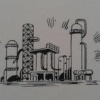Hi,
I wasn't sure if this post should be in this section or student section since its research. I am currently measuring CO2 solubility in Glycols for modeling and I have noticed for one of my measurements, the TEG has changed colour (Yellow). It may have also become more viscous however I don't have a visco-meter to check.
The system was left at 70C and 3400 PSI with excess CO2 for two days.
I was wondering if anyone has seen this before?
Is there esterification taking place?
Many Thanks in Advance

 FB
FB











